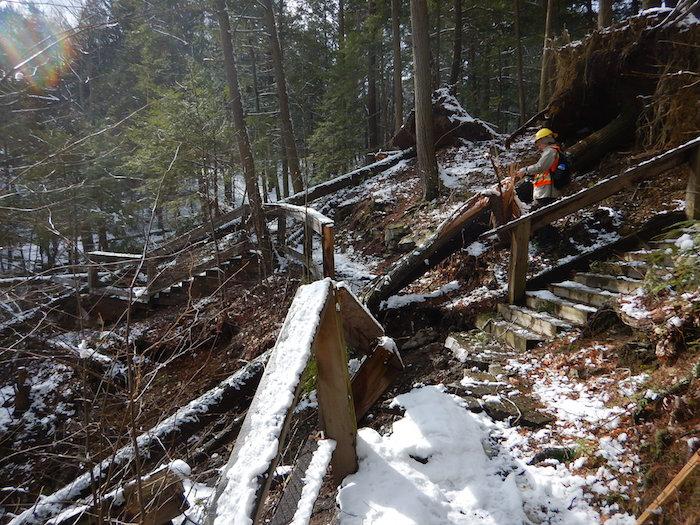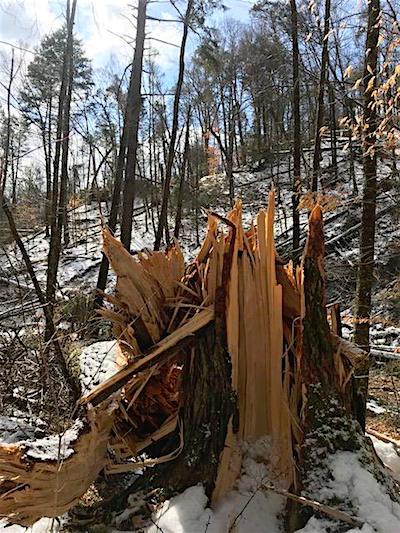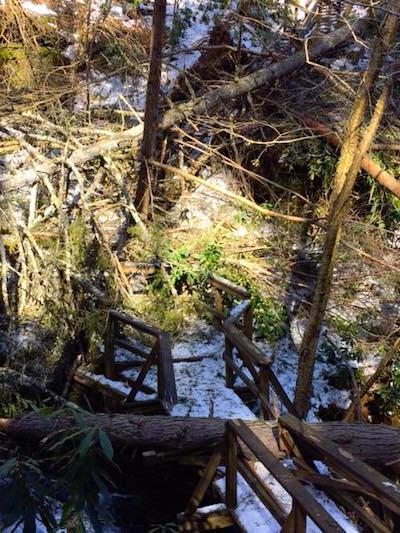
Storm damage at Delaware Water Gap NRA could take years to clean up/NPS
It could take "years" to clean up Delaware Water Gap National Recreation Area in the wake of back-to-back storms early this month that downed thousands of trees, closed trails, and possibly damaged historic structures in the park that straddles the New Jersey-Pennsylvania border, according to Deputy Superintendent Keith Farrar.
“The extent of the storm damage is both significant and widespread and it will take many months, perhaps even years in some cases, to repair,” he said. "We ask that our visitors and local residents be patient as we work through the assessments and repairs in a way that protects the public, the park’s natural and cultural resources, and our staff who are out there doing the work. It isn’t going to happen overnight and some areas will likely never look the same again.”
Damage to park trails is substantial, especially along iconic waterfall trails and ravines on the Pennsylvania side of the park where mature eastern hemlock and white pine trees dominate the landscape.
“On steeper slopes and along streambanks, wind-toppled trees took the slopes and stream banks with them when they fell resulting in destabilization of trails and hillsides, increased potential for erosion and sedimentation, and choked stream channels,” explained the deputy superintendent. “It’s much more than just cutting and removing fallen trees or rebuilding trails and bridges. We’re looking at the bigger picture, including the possibility of closing or permanently re-routing some trails to more sustainable locations rather than continually repairing damage after severe storms.”
The boardwalk trail at Dingmans Falls will likely remain closed through the summer and George W. Childs Park will remain closed indefinitely.
Here's an overview of the damage:

Thousands of trees across Delaware Water Gap NRA were downed by the storms/NPS
Pennsylvania Trails
Effective immediately, all trails on the Pennsylvania side of the park are closed due to public hazard until further notice; these areas sustained significant damage and hazardous conditions still exist, including downed trees, unstable slopes and trail surfaces, damaged bridges, and hanging and leaning trees and branches. Exceptions include the Fossil Trail at Pocono Environmental Education Center and the Raymondskill Falls Trail (from the lower parking area).
“Our crews are working to remove safety hazards from the popular McDade Recreational Trail this week so that we can re-open it as soon as possible,” said Bill Tayge, the NRA's roads and trails supervisor.
In addition to downed trees, hazards on the McDade Trail and others include a large number of “widow-makers” – loose limbs and branches precariously suspended overhead in trees with the potential to fall on those walking below. Tayge’s team will also be clearing branches and debris from the shoulders along Route 209 and other park roads this week.
New Jersey Trail
The Van Campens Glen Trail is closed due to public hazard. Other trails in New Jersey are still being evaluated. Park officials recommend that visitors refrain from hiking on trails that have not been assessed. Information on the status and conditions of park trails will be posted on the park’s website and Facebook page as it is available.

Trees fell across portions of the boardwalk trail at Dingmans Falls/NPS
Roads
All park roads that were closed due to the storm have been re-opened, although some of the township-owned roads that intersect with Route 209 on the Pennsylvania side of the park remain closed. Mountain Road in New Jersey has been re-opened with access to Buttermilk Falls, while the dirt section of Old Mine Road remains closed as part of normal winter operations. River Road in Pennsylvania may be closed on some evenings in the next few weeks to protect breeding amphibians.
Cultural Resources
Cultural resource assessments are also ongoing. Maintenance staff have been working with the park’s arborist and sawyers to remove trees from several roofs and cultural resource management staff have been evaluating damage to historic buildings and archaeological sites.



Comments
Mother nature always wins and its corollary in the real estate/building industry, water always wins.